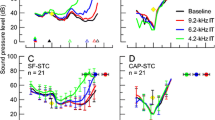Abstract
Guinea pigs were exposed to 2 kHz pure-tone or octave-band pass noise at an intensity of 100 dBSPL for 30 min. The effects of sound exposure on cochlear microphonics (CM) and compound action potential (AP) were studied using a test condition devised to complete the measurement of the sensitivity of both potentials for the frequency from 1 to 7 kHz within several minutes. The loss of CM sensitivity was limited to around 5 dB for all test frequencies in animals exposed either to pure-tone or band noise. In contrast, the loss of AP in both exposure conditions was significantly greater than that of the CM, and the magnitude of the AP losses reflected the frequency characteristics of the exposure sounds. From these observations, the AP is considered to be a more sufficient index than the CM in studing the effects of acoustic overstimulation.
Similar content being viewed by others
References
Brown JJ, Meikle MB, Lee CA (1985) Reduction of acoustically induced auditory impairment by inhalation of carbogen gas. Acta Otolaryngol (Stockh) 100:218–228
Crane HD (1966) Mechanical impact: a model of auditory excitation and fatigue. J Acoust Soc Am 40:1147–1159
Dallos P, Cheatham MA (1976) Compound action potential (AP) tuning curve. J Acoust Soc Am 59:591–597
Durrant DJ (1976) Effects of noise on cochlear potentials. In: Henderson D, Hamernik RP, Dosanjh DC, Mills JH (eds) Effects of noise on hearing, Raven Press, New York, pp 179–197
Johnstone JR, Alder VA, Johnstone BM, Robertson D, Yates GK (1979) Cochlear action potential threshold and single unit thresholds. J Acoust Soc Am 65:254–257
Lawrence M, Gonzales G, Hawkins JE (1967) Some physiological factors in noise induced hearing loss. Am Ind Hyg J 28:425–430
LePage EL (1989) Functional role of the olivo-cochlear bundle: a motor unit control system in the mammalian cochlea. Hear Res 38:177–198
Mills JH (1976) Threshold shifts produced by a 90-day exposure to noise. In: Henderson D, Hamernik RP, Dosanjh DC, Mills JH (eds) Effects of noise on hearing. Raven Press, New York, pp 265–275
Misrahy GA, Shinabarger EW, Arnold JE (1958) Changes in cochlear endolymphatic oxygen availability, action potential and microphonics during and following asphyxia, hypoxia, and exposure to loud sound. J Acoust Soc Am 30:701–704
Misrahy GA, Spradley JF, Dzinovic S, Brooks CJ (1961) Effects of intense sound; hypoxia and kanamycin on the permeability of cochlear partitions. Ann Otol Rhinol Laryngol 70: 572–581
Nakai Y, Masutani H (1988) Noise-induced vasoconstriction in the cochlea. Acta Otolaryngol (Stockh) [Suppl] 447:23–27
Patuzzi RB, Yates GK, Johnstone BM (1989) The origin of the low-frequency microphonic in the first cochlear turn of guinea pig. Hear Res 39:177–188
Patuzzi RB, Yates GK, Johnstone BM (1989) Changes in cochlear microphonic and neural sensitivity produced by acoustic trauma. Hear Res 39:189–202
Salvi RJ (1976) Central component of the temporary threshold shift. In: Henderson D, Hamernik RP, Dosanjh DC, Mills JH (eds) Effects of noise on hearing. Raven Press, New York, pp 247–262
Spoendlin H (1976) Anatomical changes following various noise exposures. In: Henderson D, Hamernik RP, Dosanjh DC, Mills JH (eds) Effects of noise on hearing. Raven Press, New York, pp 69–89
Ward WD (1963) Auditory fatigue and masking. In: Jeger J (ed) Modern developments in audiology. Academic Press, New York, pp 241–286
Wüstenfeld E (1957) Experimentelle Untersuchungen zum Problem der Schallanalyse im Innenohr. Z Mikrosk Anat Forsch 63:327–387
Author information
Authors and Affiliations
Rights and permissions
About this article
Cite this article
Yoshida, M., Aoyagi, M. & Makishima, K. Effects of acoustic overstimulation on cochlear evoked potentials. Eur Arch Otorhinolaryngol 251 (Suppl 1), S61–S64 (1994). https://doi.org/10.1007/BF02565222
Received:
Issue Date:
DOI: https://doi.org/10.1007/BF02565222




